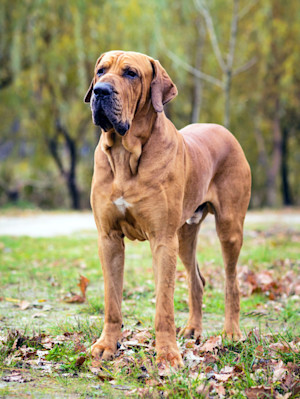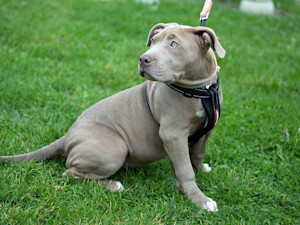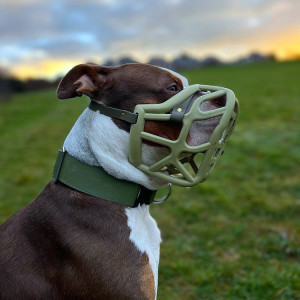How Much Do You Actually Know About XL Bullies?
How much do you really know about the dog that everyone is talking about?
You’ve probably heard more about the XL Bully than any other dog over the past few years. They’ve gained a lot of popularity in the UK since first arriving in 2014 after being bred in America in the 1990s. A lot of popularity... and a lot of controversy. But did you know that XL Bullies aren’t actually a real breed? So, what are they then? Read on to find out more.
Historicallyopens in new tab speaking – we’re talking, like, all the way back to the 1200s – Bulldogs were bred by humans with a horrible taste in spectator ‘sport’ for something called bull-baiting. The dogs would literally be set on a bull to injure and maim the larger animal until it died.
Get (totally free) deals for food, treats, accessories, tech and way more pet parenting must-haves.
After bull-baiting was banned under the UK’s Cruelty to Animals Act in 1835, Bulldogs were bred with various Terriers to create faster, more agile and aggressive breeds. The reason for this was sadly no less cruel: the Pit Bull Terrier was bred for dog fighting. Theoretically, dog fighting was also banned in the UK in 1835 but continued illegally before being clamped down on again in 1911. Sadly, illegal dog fighting is still reported in the UK todayopens in new tab.
After being bred in the US in the early 1990s the American XL Bully arrived in the UK in 2014. Some raised objections because the American Pit Bull Terrier – one of the bully breeds used to develop the XL Bully – was one of the (then) four dog breeds that had been banned in the UK in 1991 under the controversial Dangerous Dog Act alongside the Fila Brasileiro, Dogo Argentino and the Japanese Tosa. The controversy did little to hinder their popularity.
As of February 2024, following the addition of the XL Bully to the Dangerous Dog Act, the government recognises 55,000 officially exempt XL Bullies in England. It is thought that thousands more exist unregistered.
What is considered an XL Bully dog?
As the XL Bully is a ‘type’ and has not been recognised as a breed by the UK Kennel Club, specific standards do not exist, so the government created its own specificationsopens in new tab (known as a breed conformation standard) for identifying one. Animal charities warned that the specifications were unclear and caused confusion amongst dog parentsopens in new tab concerned that their dog may be considered an XL Bully.
Size
According to the government’s guidelines, the height of an XL Bully should be measured from the ground to the dog’s withers, or the top of its shoulder. They say that an adult male XL Bully will measure at least 20 inches and the female 19 inches. Dogs that do not meet this height would not be classed as an XL Bully.
Body type
The government’s guidelines say that the head of the XL Bully is heavy, large and broad, with a neck that is muscular and slightly arched, tapering from the shoulders to the base of the skull. Its shoulder blades are long and muscled, and its body of a ‘blocky build’ giving the ‘impression of great power for size’. The tail is low set and straight and the jaw well-defined and strong.
Breed
Since an XL Bully is a crossbreed, it can’t be identified definitively by DNA testing, but solely on the key physical features such as size, head and body shape.
Are XL Bully dogs dangerous?
At the end of 2023, the XL Bully dog was banned under the Dangerous Dogs Actopens in new tab. It came after a series of attacksopens in new tab were attributed to them.
According to campaigning group Bully Watch UK, in 2023 American Bully dogs were responsible for 44 percentopens in new tab of dog attacks on people, despite making up one percent of the dog population.
However, the Dog Control Coalition, an organisation comprised of Battersea, Blue Cross, British Veterinary Association (BVA), The Kennel Club, RSPCA and Scottish SPCA, which opposes breed specific legislation (the banning of specific dog breeds), say no breed of dog is inherently dangerous. Owen Sharp, the CEO of Dog‘s Trust said at the time of the banopens in new tab, “We believe in ‘deed-not-breed’; dogs should not be judged on what they look like and should have the chance to live a happy life, free from the threat of unnecessary destruction.”
The Dog Control Coalition say that breed specific legislation ignores the most important factors contributing to biting incidents – primarily anti-social behaviour by people who train their dogs to be aggressive, and irresponsible dog ownership by those who don’t train their dogs properly. Rather than a specific breed being inherently dangerous (suggesting that they are physiologically predisposed to violence) they say it is more likely to be the fault of the people who have been responsible for the dogsopens in new tab.
“In the wrong hands, these dogs can become a public safety concern – not because of the breed’s nature, but due to a lack of proper training and responsible ownership,” Nick Horniman, MRCVS and owner of MyPetsVet.co.ukopens in new tab tells Kinship. “The ban on XL Bullies, while aimed at reducing incidents of dog aggression and attacks, does not address the root cause of the problem – irresponsible ownership.”
Alarmingly, a year after the ban was announced, reports of intentional harmopens in new tab to XL Bullies surged by a staggering 164 percent compared to the same period last year.
How does the XL Bully ban work?
In September 2023, then Prime Minister Rishi Sunak said that his government had made the decision to ban the American XL Bully following a series of attacks.
“The American XL Bully dog is a danger to our communities, particularly our children,” he saidopens in new tab. “It is not currently a breed defined in law, so this vital first step must happen fast. It is clear this is not about a handful of badly trained dogs, it’s a pattern of behaviour and it cannot go on.”
England and Wales
Since 31 December 2023, it has been against the law to sell, give away, abandon or breed from an XL Bully in England and Wales. A little over a month later, on 1 February 2024opens in new tab, it became illegal to own an XL Bully dog in England and Wales unless registered on the Index of Exempted Dogs.
Dog parents who already have an XL Bully are required to have a certificate of exemptionopens in new tab from the government and comply with additional restrictions including keeping them on a lead and muzzled in public, having them neutered and possessing third party liability insurance.
The government said it received 61,000 exemption applicationsopens in new tab before the February deadline.
Anyone who chose not to keep their XL Bully was required to take it to a registered vet to be euthanisedopens in new tab by 31 January 2024.
Police can seize unregistered prohibited dogs, and their pet parents face up to six months in jail and/or an unlimited fine.
Scotland
On 1 August 2024, it became illegal to own an XL Bully Dog in Scotland without an exemption certificate or having had applied for an exemption certificate.
For pet parentsopens in new tab who decide to keep their beloved XL Bullies, they must have their dog muzzled and on a lead in public spaces, and agree not to breed, sell, gift, exchange or abandon their dog.
As the deadline to apply for a certificate of exemption has now passed, new exemptions have to be granted by a court order.
Northern Ireland
Following the restrictions of owning XL Bully Dogs in other parts of the UK, there was a significant increase in the number of XL Bully dogs in Northern Ireland, leading to new laws being introduced in the summer of 2024.
As of 5 July 2024, XL Bully dogs must be muzzled and on a lead in public spaces, and owners must agree not to breed, sell, gift, exchange or abandon their dog.
From 1 January 2025, it also became an offence to own an XL Bully without an exemption certificate.
If the pet parent of an XL Bully dog does not have an exemption certificate, the relevant council can seize their XL Bully dog, and their pet parent could face court action.
XL Bully owners wanting to get an exemption certificate must have made an application by 31 December 2024, as the scheme has now closed.
If a pet parent has not received their exemption certificate and are asked for proof of exemption by a dog warden, they can simply advise of your name and address, and the warden will be able to confirm the status of their application.
XL Bully dog: frequently asked questions
What breeds make the XL Bully?
The XL Bullyopens in new tab is a larger and more muscular version of the American Bully breed. It originated from the American Pit Bull Terrier and the American Staffordshire Terrier, but since its creation it includes a mix of breeds including the Pit Bull, American Bulldog, English Bulldog, Presa Canario and Cane Corso.
As the XL Bully isn’t a defined breed, it can make it harder to distinguish which dogs fall into the XL Bully category, hence why the UK government created its own confirmation standardopens in new tab to identify the dogs solely by their appearance.
Is an XL Bully a Pit Bull?
The American Pit Bull Terrier, or just Pit Bull, is a fighting dog first developed in the 19th century by crossing a Bulldog and Terrier. At the time, they were trained to be aggressive towards other dogs, not humans. However, after a number of fatal attacks in England and Wales between 1981 and 1991, the Pit Bull breed was banned under the Dangerous Dogs Act in 1991.
Although XL Bully Dogs mightopens in new tab have Pit Bull crossed into them, one veterinarian in England who asked to remain anonymous tells Kinship the XL Bully dog is not the same as a Pit Bull dog.
“They are distinct breeds with different character traits, behaviours and characteristics,” he tells Kinship. “They are of the same group of breed in the same way as different types of Terriers are.”
He also noted that Pit Bull Terriers are quite rare in general since the ban.
Are XL Bullies aggressive?
When you read statistics about the aggression and danger of XL Bully Dogs, you’ll very quickly come upon comments arguing the aggression is the fault of the owners, not the dogs. You might hear stories about XL Bullies who fit right into the family and are safe around kids.
“It’s crucial to acknowledge that no breed is inherently aggressive,” Dr Horniman says. “The temperament of a dog, including XL Bullies, is influenced by multiple factors such as genetics, upbringing, training and socialisation. Like any large and powerful breed, XL Bullies require responsible ownership, firm but compassionate training, and proper socialisation from a young age. When these needs are not adequately met, the risk of undesirable behaviours including aggression increases.”
References
Silver, Carly. “Bulldog History: A Wrinkle in Timeopens in new tab.” American Kennel Club, American Kennel Club, 26 Mar. 2024.
“XL Bully Conformation Standardopens in new tab.” GOV.UK, 1 Feb. 2024.
Defra Press Office. “XL Bully Registrations.opens in new tab” Defra in the Media. 27 Feb. 2024.
“Dangerous Dogs Act 199opens in new tab 1.” Legislation.Gov.Uk, Statute Law Database, 25 July 1991.
“XL Bully Dogs in Scotlandopens in new tab.” Scottish Government, The Scottish Government, 22 Oct. 2024.
“XL Bully Dogsopens in new tab.” Nidirect | Tedireach , 8 Jan. 2025.









